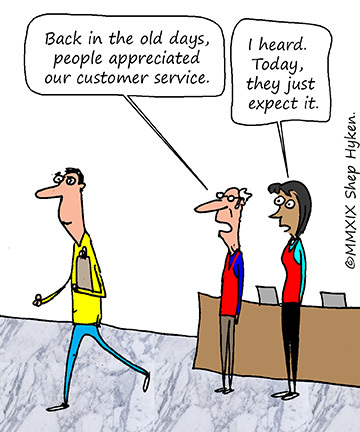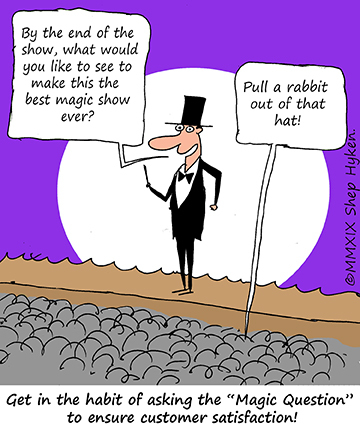Shep Hyken's Blog, page 116
November 15, 2019
Guest Blog: Three Surprising Ways You Can Improve the Customer Experience with Cloud IVR
This week we feature an article by Nogol Tardugno who tells us how to get our contact center interactive voice response (IVR) to deliver the best customer experience.
Any reports of the death of interactive voice response (IVR) as a customer service channel have been greatly exaggerated. In 2019 businesses continue to fund their IVR call solutions as statistics both formal and anecdotal continue to demonstrate the need. Forrester, for instance, has reported that nearly 40 percent of customer service interactions still take place over the phone.
You’ve heard by now of all the practical ways that today’s dynamic IVR can support your customer experience, including:
Providing simple self-service functions such as balance checking or order status without needing to talk to an agent
Offering faster, more convenient service at literally any time
But what about ways a cloud IVR could achieve the cliché and “delight” your customers — or, dare we say, even surprise them?
The most meaningful surprise for your customers (and your bottom line) would be an IVR that, from dial tone to “goodbye,” is quick and easy to use and operates in an intuitive manner, providing a customer journey that could make them glance at the phone and think, “Wow, I’m done already?!”
So how can your contact center IVR get there?
Get Straight to the Point
When you need help from a business, nothing is more frustrating than to hear the “we are experiencing unusually high call volume” message as soon as the call picks up. A cloud IVR can benefit your contact center and your customers from the second a call is placed. Because the cloud service can be scaled according to need, your team can have the right number of agents available at any time without the need for extra hardware that isn’t often needed. Further, when you want customizable features such as artificial intelligence applications (see below), you don’t have to buy expensive enterprise tools or hire the technical experts required to use them. The outcome is that cloud IVR keeps your queue flowing smoothly and call spikes don’t affect your incoming callers – which is particularly reassuring to those who are simply trying to access your self-service options.
Along with a quick and effective customer experience, today’s customers most appreciate businesses that make an effort to respect their time and demonstrate that their mutual relationship is important. This personalized service leads to a higher perception of quality, and if your IVR can tap into your customer data from other channels, previous interactions, and your CRM, each call can be a quality experience.
This sort of dynamic IVR can surprise your customers by:
Immediately recognizing them and greeting them by name
Proactively offering personalized menu actions due to their recent activity in other channels: “I see you’ve recently viewed your checking account online. Do you need help with one of the following transactions?”
Accessing their service and purchase history and proactively offering information on the customer’s potential needs, such as service updates or product training
As mentioned above, this is an area where cloud IVR really shines because it functions through pre-built and customizable applications that “ride” over the top of your existing legacy systems. These applications are comparatively easy to install and implement, meaning your customers’ phone experience can improve within days or weeks instead of months.
Stop Pushing Buttons
The concept of IVR has been around a long time, but it’s finally, efficiently living up to its name: it can be interactive and accept voice responses in a conversational dialog. AI-powered IVR applications use natural language processing to let callers simply state why they’re calling – particularly pleasant for the ever-growing number of customers calling from a mobile device who may actually be mobile and unable to easily access a keypad. These apps can determine caller intent and automatically direct them to the right destination, whether it’s a self-service function or an agent. This clearly accelerates your call routing and decreases overall call time, which means higher rates of customer satisfaction.
Leverage Your Data
In today’s data-driven world, how can you make sure your customer experience is really what you need it to be, and even improve it over time? It may surprise your customers to be asked for their opinion of your service at the same time the service is going on. IVR-implemented Voice of the Customer (VoC) surveys collect timely, accurate feedback while the experience is still fresh in their minds – and you can immediately leverage that data to optimize your internal operations. The IVR can link back to your customer data, modify survey questions in real-time, and collect personalized feedback. You can quickly and effectively measure the results of product launches, gather data for new programs, and analyze the effectiveness of services. This new data will show you what already works and suggest what areas can be improved.
Along with VoC tools, cloud IVR applications can offer user-friendly tools for A/B testing your call experience and quickly hone in on the structures and experiences your customers find most intuitive and successful.
So there are three ways that your IVR can be updated to offer a customer experience that is consistently refined to be faster, smoother and, yes, more surprising for your customers. It may even come as a surprise to you, your operations team, or your C-suite what benefits your company can expect from implementing this simple solution that delivers a consistent, centralized experience across all of your channels. Simply put, a cloud IVR gives you complete control over your digital voice channel, and its customizable, pre-built applications can streamline the development and management processes even further.
Nogol Tardugno is the Director of Customer Success at Plum Voice. With over 18 years of experience, she is passionate about delivering the best customer journey through the use of technology. She has a background in Computer Information Systems and has worked in financial, digital marketing and CPaaS industries.
For more articles from Shep Hyken and his guest contributors go to customerserviceblog.com.

Read Shep’s latest Forbes article: Hacks For Using Video To Enhance The Customer Experience
The post Guest Blog: Three Surprising Ways You Can Improve the Customer Experience with Cloud IVR appeared first on Shep Hyken.
November 13, 2019
10 Years Ago, Customer Service Was Appreciated—Today, It’s Expected
 It wasn’t that long ago that you would go to a store, dine at a restaurant, do business with a vendor or call a customer support center and notice how good the customer service was. A great service experience stood out. It was noticed. It was a differentiator.
It wasn’t that long ago that you would go to a store, dine at a restaurant, do business with a vendor or call a customer support center and notice how good the customer service was. A great service experience stood out. It was noticed. It was a differentiator.
I started my speaking business in the 1980s. I know, I look much younger than I actually am, but it really was that long ago. Back then, the rock star company that was known for customer service was IBM. They recognized that if they created enough value beyond the actual product, that price would seem less important. That brings me to Lou Sterns, Distinguished Professor Emeritus of Marketing at Kellogg School of Management at Northwestern University.
I had the chance to attend a weekend marketing program at Kellogg with Professor Stern. He shared a case study that I’ve often thought about and even referenced in my articles and videos. Professor Stern was hired to consult with IBM when they were selling computers. As they were becoming more affordable—yet still quite expensive by today’s standards—and more popular, the goal was to make price irrelevant, or at least less relevant. He listed 20 reasons why a customer would choose to buy an IBM computer. On the list were words like quality, reliability, fast response, quick repairs, capability and of course there was price. As customers were surveyed, they were asked to rank these 20 words based on how important they were to the decision of buying an IBM computer.
The short story is that price didn’t make it into the top ten. It was actually near the bottom of the list. That’s how you know that your customer service and experience is appreciated—when your customer feels the price is not nearly as important.
Let’s jump to today’s competitive business world. Customer service and CX are almost always in front of mind. People may still appreciate a good service experience, but it must be so good that it is noticed. That’s because the bar has been raised. Yesterday’s IBM has been replaced today by companies like Amazon, Apple, Nordstrom and other brands recognized for a stellar customer experience. As I often say, those brands set the bar higher for everyone. They create an expectation that when a customer goes into any other type of business, they will receive that same great service. Customer service is no longer a “nice-to-have-it” luxury. It’s an “expected-to-have-it” resource. When a customer gets it, they appreciate it. They show their appreciation by coming back.
So, how do you meet today’s standards? There are two ways you can start.
First, create a service experience that is consistently and predictably above average. By being just a little bit above average—all the time—customers will say, “They are amazing!” By the way, it’s the “all the time” part that’s hard.
Second, if you want to create a better service experience, look at your favorite companies to do business with. What do you like about them? More importantly, what do you love about them? Can you bring whatever that is to your own business? I bet you can. Figure that out, and you’re on your way to a better customer service experience.
Shep Hyken is a customer service expert, keynote speaker, and New York Times bestselling business author. For information, contact 314-692-2200 or www.hyken.com. For information on The Customer Focus customer service training programs, go to www.thecustomerfocus.com. Follow on Twitter: @Hyken
customer service training programs, go to www.thecustomerfocus.com. Follow on Twitter: @Hyken
(Copyright © MMXIX, Shep Hyken)
The post 10 Years Ago, Customer Service Was Appreciated—Today, It’s Expected appeared first on Shep Hyken.
November 12, 2019
Amazing Business Radio: Dennis Snow
 Create a Disney-Worthy Customer Experience
Create a Disney-Worthy Customer ExperienceBuilding a magical customer experience at every level
Shep Hyken interviews Dennis Snow. They discuss how to define an organization’s level of service and company culture by looking at examples from the Walt Disney World Company.








Top Takeaways:
There are two steps to defining your organization’s level of service. Step one is to ask yourself what you want your customers to say about their experience. Step two is to ask yourself what you can do to get your customers to say those things.
When considering step one, narrow it down to three things you want your customers to say. This helps you focus on what differentiates you from others.
Your culture is defined by step two. Reinforce the behaviors that elicit the desired customer response. Your company culture is not what you say but what you do.
Good company culture starts with the hiring process. Get to know your standout employees and find out what qualities contribute to their success within your organization. Then, hire individuals who are similarly hard-wired to succeed within your culture.
Training begins during the hiring process. You must demonstrate your company’s values from the beginning, and that includes the hiring process.
The first day of training should focus on company culture. Additionally, this training should never end.
Identify behaviors that detract from the brand and culture you have worked so hard to craft. Be on the lookout for these and create processes that prevent them from happening.
As a leader, never let a coachable moment pass you by. Seize opportunities to continually coach your employees toward improvement.
Similarly, never let a moment of recognition go by. Give praise and credit where it’s due, and positively reinforce the behavior that defines your brand.
Leaders must demonstrate and embody the values and culture they want to see throughout their organization. They must not only talk the talk but also walk the walk; leaders are the ultimate role model for company culture.
Quotes:
“What people say is your brand; what your employees do is your culture.” – Dennis Snow
“Identify what the customer experience is supposed to be, and then identify the employees’ responsibility in making that happen.” – Dennis Snow
“Training begins during the hiring process.” – Dennis Snow
“It’s not about the job you do, it’s about the experience you create.” – Dennis Snow
About:
Dennis Snow is a full-time speaker, trainer and consultant. He worked with the Walt Disney World Company for over 20 years, where he developed his passion for service excellence.
Shep Hyken is a customer service and experience expert, New York Times bestselling author, award-winning keynote speaker, and your host of Amazing Business Radio.
This episode of Amazing Business Radio with Shep Hyken answers the following questions … and more:
How do I define my organization’s level of service?
How do I create my company culture?
How do I hire right?
How do create a good customer experience?
How do I train to my company’s values?
The post Amazing Business Radio: Dennis Snow appeared first on Shep Hyken.
November 11, 2019
5 Top Customer Service Articles for the Week of November 11, 2019
Each week I read a number of customer service and customer experience articles from various resources. Here are my top five picks from last week. I have added my comment about each article and would like to hear what you think too.
3 Ways Store Layout Decisions Impact on Customer Experience by Oisin Ryan
(ServiceDock) The following covers three of the most common and obviously non-customer-centric strategies that retailers use. Each of them maximizes short term profitability but at the potential expense of long term customer loyalty. These examples focus primarily on supermarkets but the thinking behind them could easily be applied to other retail businesses.
My Comment: While this article is focused on retail, I think it has application to every type of business. The example in the article is about a supermarket. There’s a reason the “staples,” like milk and bread at the back of the store. The store is looking to maximize profitability by making the customer walk by the other merchandise, hoping they will make an extra purchase. A customer just looking to pick up a carton of milk sees the layout as inconvenient. So, what ideas do we make in our businesses that are more profitable and inwardly focused versus customer focus?
Why Is Identity So Important In Today’s Customer Experience? by Matt Seeley
(AdAge) The foundation for personalized customer experience starts with identity and rich consumer data.
My Comment: I like the word “identity,” and as it applies to CX and service, how it delivers a better experience. So, do you know who your customers are? More specifically, do you know who each customer is? The ability to identify a customer is a powerful opportunity for personalization that, thanks to today’s CX technology, is starting to become more and more common.
Weeding Through the Customer Experience Gap by Aaron Perlut
(Elasticity) A recent article in Campaign by Lindsay Stein focuses on the customer experience gap. She cites SAP Chief Marketing Officer Alicia Tillman who says, “…we live in an experience economy and what that means is business is won or lost based on the experience we deliver to our customers.”
My Comment: Here’s another business definition of a “gap” in business. It’s the difference between what a customer experiences with a great brand and what they experience with any brand that isn’t great. He mentions the difference between the simplicity and ease of doing business with Amazon versus the long line and wait time at a coffee shop at a busy airport. Your customers have a new expectation, and it’s not set by your competition. It’s set by the best service they have ever had. So, what’s your gap?
3 Steps to Building a Customer-Centric Organization by Kristin Raza
(CIO) Create customer-centricity by delivering seamless experiences, leveraging IT’s unique insights, and evolving your leadership mindset.
My Comment: I like most articles that cover the corporate culture and customer experience. Since it came from the CIO publication, it directs the comments to the CIO, but it really can be good for anyone in leadership. There are three great tips; focus on delivering seamless experiences, take advantage of IT’s insights to improve a process and have a customer-centric leadership mindset.
4 Things to Consider Before Building a Review System by Matt Wujciak
(CCW Digital) Designing and maintaining a review ecosystem can be to your advantage. Think of this platform as a garden that requires constant monitoring and innovative ideas to grow your brand and gain consumer intelligence.
My Comment: There are review sites for virtually any industry – B2B and B2C. Many companies are concerned about the more public reviews on Yelp and Facebook. As the article points out, “Unless you have a reason to hide in the bushes, you shouldn’t look so guilty. The fact is that a company should embrace their reviews, good and bad. They show you you’re doing things right, or show you opportunities to make things better.
 Shep Hyken is a customer service expert, professional speaker and New York Times bestselling business author. For information on The Customer Focus
Shep Hyken is a customer service expert, professional speaker and New York Times bestselling business author. For information on The Customer Focus customer service training programs go to www.TheCustomerFocus.com. Follow on Twitter: @Hyken
customer service training programs go to www.TheCustomerFocus.com. Follow on Twitter: @Hyken
The post 5 Top Customer Service Articles for the Week of November 11, 2019 appeared first on Shep Hyken.
November 8, 2019
Guest Blog: Culture Starts at the Top
This week we feature an article by Liliana Petrova who writes about how important the leader’s role is in the culture of an organization. Leadership sets the tone. They are the role models for the rest of the employees.
Today, I want to talk about how to get the right culture in your organizations. First and foremost, you need the right leader. Without a leader who believes that today’s business success is about acquiring and retaining customers, you cannot even begin the process of building a culture. Leaders who are passionate about the customer are also passionate about creating culture and employee engagement.
How Leaders Create Culture
Leaders create the culture of an organization. Their actions and words form the storytelling and folklore of the company. That is the strongest source of culture. Folklore is not designed. It is an account of what happened. In that sense, the leader at the top defines the culture of his/her company.
Dave Barger, the former CEO of JetBlue Airways, remembered the name of every employee he met. He stopped employees in the hallway to shake hands or high five. Every new hire knew the stories about Dave Barger. The CEO and his values were part of the folklore – and the identity – of the company. Airline employees knew Dave as the man who started his career as a bag handler. He was someone who walked the talk because he knew firsthand what it is like to be on the front line.
These kinds of stories can’t be choreographed. If they were, they would not be retold by employees. Nor would they be embraced.
Dave used to fly to Orlando, where JetBlue’s training center is, to meet every new employee as part of an Orientation process for new hires of all ranks. Every two weeks, he spent two days in Orlando telling the story of how the company started and sharing his passion for the industry with flight attendants, bag handlers, and support function new hires.
The Mechanics of Culture
So how was culture instituted in JetBlue’s case? Once people knew what a caring and passionate leader Dave Barger was, they wanted to emulate him. Even more, they wanted him to be proud of them. So they tried to do what he did in their small orbits of influence.
And it worked. The General Manager of Boston took care and connected with all his employees in the operation. The VP of the Contact Center made the offices in Salt Lake City a home for all her employees, supporting them through personal and family struggles. The culture “JetBlue is your family” started with the CEO. But it did not end with him.
The company culture that stimulated employee engagement and fueled customer experience could not have grown without a leader who “lived the values” every day of his life.
Culture Goal is Real
According to Lumoa “Only 13% of companies believe that HR has an impact on Customer Experience activities in the company.” This is one of the reasons so many companies have a hard time making CX part of their core value proposition. A great leader knows that culture needs both folklore to inspire, and a reward system to acknowledge when cultural values are done right.
When culture is important to the leader, he/she incorporates it into a culture goal for the executive team. In JetBlue for example, HR managed the culture goal. And it accounted for 20% of the goals for all Directors. Part of the culture goal was to adopt a city station and visit the employees four times a year. What do you think happened when it rained and we still had to travel to our respective cities? We all went since there was an incentive to do so.
Include HR in Culture Goals
HR is integral not only in the culture goal-setting process but also in the programming of events and initiatives that bring that culture to the daily lives of employees.
That programming is essential to promoting and maintaining culture in your organization, for the benefit of employees and customers, as we will explore in some exciting upcoming conversations.
Keep Culture Top of Mind
What you need to walk away knowing right now is that, when culture is top of mind for leadership, leadership supports employees who live out culture goals. Let’s carry through the JetBlue example. Under Dave Barger, caring was a culture goal. Employees earned credit for volunteering outside the organization. And employees with the most hours were honored at a gala dinner with the CEO and executive team (that means real face-time with leadership).
Compensation and rewards like this – moments of awe for employees – close the loop with the executive team. That is how we build cultures in organizations in a way that shows results in the daily life of employees and the experience of customers.
So, if you are serious about culture, hire the right leader for your organization and start building from there.
Liliana Petrova is the CEO/Founder at The Petrova Experience. She helps BtoB & BtoC brands design customer-centric cultures, build differentiated experiences, and leverage technology to increase customer loyalty, efficiencies and revenue.
For more articles from Shep Hyken and his guest contributors go to customerserviceblog.com.

Read Shep’s latest Forbes article: Five Ways Salespeople Can Contribute To A Great Customer Experience
The post Guest Blog: Culture Starts at the Top appeared first on Shep Hyken.
November 6, 2019
The Magic Question
 What I’m about to share with you is a simple question to ask your customers—and even your employees—that will help you meet, and even exceed their expectations. This question is about success, for both you and your customers.
What I’m about to share with you is a simple question to ask your customers—and even your employees—that will help you meet, and even exceed their expectations. This question is about success, for both you and your customers.
First, a little background. I’ve been a part of Dan Sullivan’s Strategic Coach program for 20 years. Once a quarter, I meet with my coach and spend the day working on my future. My belief is that success doesn’t happen by accident, and the Strategic Coach program has helped make my quest for success a purposeful effort. One of the most powerful lessons Dan teaches is what he originally referred to as the “R-Factor Question” and now refers to as the “Dan Sullivan Question.” I like to refer to it as the “Magic Question.”
When I was considering joining the Strategic Coach program, Dan asked, “If we were to get together three years from now, what would have to happen professionally and personally for you to feel this was a valuable investment of your time and money?”
Why was this question so great? It did two things. It forced me to think of myself in the program. When I answered, it told Dan what I considered to be my most important success criteria. Once he knew, he could play to that need and confirm that he could meet my expectations.
I thought about this question quite a bit and realized that it can be used for virtually any situation. While Dan was using it for sales, it could also be used for customer service. Imagine a customer calls with a complaint. You could apologize, acknowledge the customer’s issue and ask a typical question such as, “What would make you happy?” Or you could ask the Magic Question, which is, “If we were to talk again in six months, what would have to happen for you to be happy with our product?”
When you ask it that way, the two things already mentioned happen. First, the customer thinks about themselves happily using the product or service. Second, they share their expectation—once you know what that is, you can confirm or adjust if necessary.
Think about different situations where you could ask the Magic Question. We’ve covered sales and service, but you can use this question almost anywhere. For example, your boss may want you to prepare a report. You could ask, “When this report is finished in a week, what would it need to have in it for you to be 100% happy with it?” You could be working with another employee or team and want to know what would make them happy. Asking the question in this manner is a powerful way to understand success and what it takes to make others happy.
So… if we were to get together a year from now, what would have to happen for you to feel that reading these Shepard Letter articles would be a valuable investment of your time?
Shep Hyken is a customer service expert, keynote speaker, and New York Times bestselling business author. For information, contact 314-692-2200 or www.hyken.com. For information on The Customer Focus customer service training programs, go to www.thecustomerfocus.com. Follow on Twitter: @Hyken
customer service training programs, go to www.thecustomerfocus.com. Follow on Twitter: @Hyken
(Copyright © MMXIX, Shep Hyken)
The post The Magic Question appeared first on Shep Hyken.
November 5, 2019
Amazing Business Radio: Augie Ray
 The Bottom Line of Customer Experience
The Bottom Line of Customer ExperienceCreating a Customer Experience that Results in Financial Gain
Shep Hyken interviews Augie Ray from Gartner. They discuss the importance of investing in the customer experience and how to build a CX that will benefit both customers and companies alike.








The Interview with Augie Ray:
The emergence of new technology and the rise of social media have changed the way customers interact with brands, giving them more channels of communication than ever before. Brands need to pay attention to the entire customer experience across all channels to stay relevant and successful.
Simply acquiring new customers isn’t enough, especially if you experience high customer churn. Create an experience that focuses on retaining customers and building loyalty—and that experience is the result of not just what we say, but what we do.
There are two different definitions of customer experience, and they are two sides of the same coin.
From the customer’s perspective, CX is their accumulated experiences and perceptions about a brand through every interaction, both direct and indirect.
From a managerial perspective, CX is the discipline of understanding and reacting to customer interactions with the goal of meeting and exceeding expectations, creating loyalty and building advocacy.
As customer expectations rise, budgets for customer experience need to rise as well.
Data shows there is a positive relationship between customer satisfaction and financial gains for businesses. Prioritizing the customer experience benefits the top and bottom lines.
Both segments and personas are marketing tools that allow companies to group individuals together in a meaningful way. Segments demonstrate how customers are meaningful to a company, whereas personas flip the perspective and examine how a brand can be meaningful to customers.
To access the research that Augie quotes, listeners are invited to connect with him on LinkedIn and to subscribe to Gartner’s newsletter, “Smarter with Gartner.”
Quotes:
“We are not what we say we are. We are the experience we provide to customers and what they say we are.” – Augie Ray
“When it comes to the customer experience, we have to look not just at what we say, but at what we do.” – Augie Ray
“When you succeed for the customer, you succeed for the brand as well.” – Augie Ray
About:
Augie Ray is a Vice President Analyst at Gartner, a research and advisory firm. He covers customer experience for marketing and CX leaders and helps them launch and manage successful CX programs.
Shep Hyken is a customer service and experience expert, New York Times bestselling author, award-winning keynote speaker, and your host of Amazing Business Radio.
This episode of Amazing Business Radio with Shep Hyken answers the following questions … and more:
What is the definition of customer experience?
What is the difference between segments and personas?
How does the customer experience relate to marketing?
Is investing in the customer experience worth it?
How do I create a good customer experience?
The post Amazing Business Radio: Augie Ray appeared first on Shep Hyken.
November 4, 2019
5 Top Customer Service Articles for the Week of November 4, 2019
Each week I read a number of customer service and customer experience articles from various resources. Here are my top five picks from last week. I have added my comment about each article and would like to hear what you think too.
Gypsy and Your Customers Expect Kindness by Chip Bell
(Forbes) Your customers are a lot like Gypsy in their expectation of kindness. Their trips to Starbucks or Chick-fil-A or Trader Joe’s or lots of other places that deliver exceptional service have taught them to expect respectful attention and kind treatment.
My Comment: Halloween was this past Thursday. I read this article from my fellow customer service expert and couldn’t resist sharing. He writes about looking through service and kindness through his black cat’s eyes. Nothing spooky about that cat. Just some good customer service insights.
[Infographic] ‘Channel’-ing Your Customers Expectations by Zareen Islam
(Gladly) A look at the channels your customers are on, how long they’ll wait for service on each, and their expectations when it comes to their experience between them.
My Comment: I’m often asked which channels do companies need to be on to best support their customers. This is a great look at the channels your customers are on as well as their expectations for each channel.
Infographic: We expect a personalized experience by Customers 2020
(Walker Insights) The reality is, we all want to be treated as an individual. We want the companies we do business with to value us as a person, not a number. And, it doesn’t just apply to customers. It’s also about employees, partners, investors, our community, etc.
My Comment: Our customers enjoy a personalized experience. They want to do business with a company where, like the theme song to the TV sitcom “Cheers” implies, “everybody knows your name.” This article and infographic are a quick look at the power – and challenges – to creating the personalized experience that our customers are looking for.
Take Your Personalized Marketing One Step Further To Increase Customer Loyalty: 13 Expert Tips by Forbes Communications Council
(Forbes) To help those companies interested in going above and beyond in their marketing efforts, 13 members of Forbes Communications Council offer insight into what methods a business can incorporate into their personalized marketing to make an unforgettable impression on the customer and gain a loyal following.
My Comment: And, as long as we’re on the topic of personalization, here’s a compilation of 13 experts sharing their tips; everything from data to digital to human is covered.
17 Resources for Customer Support Professionals: What to Read, Who to Follow, and How to Connect by Valeriya Yordanova
(Sessionstack) Even though access to information is only one google search away, it’s still difficult to find and choose the resources that will help you and your team grow, learn, and connect.
My Comment: If you want to keep up with your customer service and experience reading, then you’ll want to keep this list close by. Session Stack has compiled a list that includes customer support stats and reports (from Salesforce, McKinsey and more) to who to follow in social media (experts like Annette Franz, Jeanne Bliss and others) and what Blogs to read (from organizations like Forester and Hubspot).
BONUS
The Greatest Avenger of the CX Universe by Jeremy Watkin and Community
(CX Accelerator) You are looking to hire one Avenger from the Marvel Cinematic Universe who will build the best CX program in all of the universe. Which Avenger would you hire and why?
My comment: Couldn’t resist adding this one to the list – especially with the Halloween theme of Chip Bell’s article listed above. If you were thinking of what costume you would have worn if you were a customer service super-hero, then you’ll love this article. And, you’ll get to see why I think Spider-Man is the super-hero of choice… And, you’ll see what I look like in a Spider-Man outfit!
 Shep Hyken is a customer service expert, professional speaker and New York Times bestselling business author. For information on The Customer Focus
Shep Hyken is a customer service expert, professional speaker and New York Times bestselling business author. For information on The Customer Focus customer service training programs go to www.TheCustomerFocus.com. Follow on Twitter: @Hyken
customer service training programs go to www.TheCustomerFocus.com. Follow on Twitter: @Hyken
The post 5 Top Customer Service Articles for the Week of November 4, 2019 appeared first on Shep Hyken.
November 1, 2019
Guest Blog: How to Use Customer Journey Mapping for Impressive Customer Experience?
This week we feature an article by Linda Taylor who writes about the importance of customer journey mapping in every organization in order to improve the customer experience.
Customer Journey Mapping is a pictorial representation of the path a customer follows after coming in contact with a company. The diagramming technique captures the multiple interactions customers make with businesses at varied touch-points. Such in-depth mapping allows enterprises to visualize the buyer’s experience.
Companies aim to identify the key interactions a customer enjoys with their processes from the moment they come in touch till the moment they make a purchase. Customer journey mapping is never 100 percent accurate but it highlights metrics, which can be used to improve customer experience.
A properly mapped customer journey must reveal the following:
Customer’s motivation: The motif of a customer behind interacting with your business.
Multiple touchpoints: The actions a user takes while interacting with the company.
Channels: Whether the customer is interacting with your business through social media, retail stores or a mobile app.
Customer Journey Mapping can be divided into three categories:
The Typical B2B Customer Journey Map: Pictorially represents touchpoints a customer engages with through the journey.
The Tactical B2B Customer Journey Map: This mapping technique is used to map a specific event (pain-points) in the customer journey.
The Performance & Improvement Customer Journey Map: Designed to help businesses identify pain-points, this mapping technique focusses on in-depth analysis.
Why businesses need Customer Journey Mapping?
With enterprises diverting their funds towards customer experience innovation, mapping a user’s journey can help businesses discover important pain points and bottlenecks. Corporates defy mapping because they believe it to be an accurate measurement that can giveaway important nuances of their business. Whereas mapping is just a diagramming technique of the customer’s experience.
Businesses should do Customer Journey Mapping because:
It helps them discover pain-points, which is affecting a user’s experience
It assists in streamlining cross-department services to help customers enjoy a seamless experience
Mapping can help enterprises understand the emotions of customers
It assists businesses in building compelling collateral and improving the customer’s journey
Impact of Customer Journey Mapping on Customer Experience
Corporates have always debated the need for customer journey mapping but they have been doing it regardless of opinions. Mapping continues to be a popular way of analyzing customer behavior, which can be tamed to benefit the organization.
With a lot riding on customer experience improving it with the help of journey mapping will leave no rooms for errors. When customers are provided with incomparable user-experience, they will buy again and bring in referrals too.
Here’s how customer journey mapping impacts customer experience:
It gives an overview of how customers are moving on your site, interacting with the funnels, making it easier for managers to identify bottlenecks and remove them.
Mapping highlights the following gaps and offers an opportunity to improve customer experience:
Lack of similar experience when the customer moves from one device to the other
Lack of coordination between departments, which might irritate the customers
Lack of seamless transactions between channels (in case users are visiting the website from social media).
Customer Journey Mapping Helps Customer Achieve their Goals
The real success of an enterprise lies in letting their customers win. By rectifying all errors highlighted through mapping, enterprises can improve customer experience and ensure a seamless transition between channels. Also, journey mapping enhances the chances of garnering results by tweaking touchpoints and propositions.
Customer Journey Mapping Positions Your Company to Win
With focus shifting from price point to customer experience, enterprises are betting highly on experience. Enterprises are acquiring journey mapping services to discover pain-points and render them obsolete. 90% of managers who conducted journey mapping, agrees that their conversions have improved and their customer experience is sky-rocketing.
Conclusion
Customer Journey Mapping paves the way for customers to succeed, positions your business to win and enables better user-experience. By journey mapping businesses can discover and remove processes or operations that are either troublesome or not contributing to the bigger picture. If used efficiently, journey maps can help with cost-cutting and improve return on investment.
Linda Taylor is an experienced business and marketing consultant with MattsenKumar LLC. Linda’s vast exposure in growing B2B SMEs and improving Customer Experience enables her to create quality content in the form of Articles and Infographics. With a focus on benefiting the masses, Linda is creating content that adds value and routes companies towards success.
For more articles from Shep Hyken and his guest contributors go to customerserviceblog.com.

Read Shep’s latest Forbes article: Customer Experience Continues To Get Better Even If Loyalty Doesn’t
The post Guest Blog: How to Use Customer Journey Mapping for Impressive Customer Experience? appeared first on Shep Hyken.
How to Use Customer Journey Mapping for Impressive Customer Experience?
This week we feature an article by Linda Taylor who writes about the importance of customer journey mapping in every organization in order to improve the customer experience.
Customer Journey Mapping is a pictorial representation of the path a customer follows after coming in contact with a company. The diagramming technique captures the multiple interactions customers make with businesses at varied touch-points. Such in-depth mapping allows enterprises to visualize the buyer’s experience.
Companies aim to identify the key interactions a customer enjoys with their processes from the moment they come in touch till the moment they make a purchase. Customer journey mapping is never 100 percent accurate but it highlights metrics, which can be used to improve customer experience.
A properly mapped customer journey must reveal the following:
Customer’s motivation: The motif of a customer behind interacting with your business.
Multiple touchpoints: The actions a user takes while interacting with the company.
Channels: Whether the customer is interacting with your business through social media, retail stores or a mobile app.
Customer Journey Mapping can be divided into three categories:
The Typical B2B Customer Journey Map: Pictorially represents touchpoints a customer engages with through the journey.
The Tactical B2B Customer Journey Map: This mapping technique is used to map a specific event (pain-points) in the customer journey.
The Performance & Improvement Customer Journey Map: Designed to help businesses identify pain-points, this mapping technique focusses on in-depth analysis.
Why businesses need Customer Journey Mapping?
With enterprises diverting their funds towards customer experience innovation, mapping a user’s journey can help businesses discover important pain points and bottlenecks. Corporates defy mapping because they believe it to be an accurate measurement that can giveaway important nuances of their business. Whereas mapping is just a diagramming technique of the customer’s experience.
Businesses should do Customer Journey Mapping because:
It helps them discover pain-points, which is affecting a user’s experience
It assists in streamlining cross-department services to help customers enjoy a seamless experience
Mapping can help enterprises understand the emotions of customers
It assists businesses in building compelling collateral and improving the customer’s journey
Impact of Customer Journey Mapping on Customer Experience
Corporates have always debated the need for customer journey mapping but they have been doing it regardless of opinions. Mapping continues to be a popular way of analyzing customer behavior, which can be tamed to benefit the organization.
With a lot riding on customer experience improving it with the help of journey mapping will leave no rooms for errors. When customers are provided with incomparable user-experience, they will buy again and bring in referrals too.
Here’s how customer journey mapping impacts customer experience:
It gives an overview of how customers are moving on your site, interacting with the funnels, making it easier for managers to identify bottlenecks and remove them.
Mapping highlights the following gaps and offers an opportunity to improve customer experience:
Lack of similar experience when the customer moves from one device to the other
Lack of coordination between departments, which might irritate the customers
Lack of seamless transactions between channels (in case users are visiting the website from social media).
Customer Journey Mapping Helps Customer Achieve their Goals
The real success of an enterprise lies in letting their customers win. By rectifying all errors highlighted through mapping, enterprises can improve customer experience and ensure a seamless transition between channels. Also, journey mapping enhances the chances of garnering results by tweaking touchpoints and propositions.
Customer Journey Mapping Positions Your Company to Win
With focus shifting from price point to customer experience, enterprises are betting highly on experience. Enterprises are acquiring journey mapping services to discover pain-points and render them obsolete. 90% of managers who conducted journey mapping, agrees that their conversions have improved and their customer experience is sky-rocketing.
Conclusion
Customer Journey Mapping paves the way for customers to succeed, positions your business to win and enables better user-experience. By journey mapping businesses can discover and remove processes or operations that are either troublesome or not contributing to the bigger picture. If used efficiently, journey maps can help with cost-cutting and improve return on investment.
Linda Taylor is an experienced business and marketing consultant with MattsenKumar LLC. Linda’s vast exposure in growing B2B SMEs and improving Customer Experience enables her to create quality content in the form of Articles and Infographics. With a focus on benefiting the masses, Linda is creating content that adds value and routes companies towards success.
For more articles from Shep Hyken and his guest contributors go to customerserviceblog.com.

Read Shep’s latest Forbes article: Customer Experience Continues To Get Better Even If Loyalty Doesn’t
The post How to Use Customer Journey Mapping for Impressive Customer Experience? appeared first on Shep Hyken.



